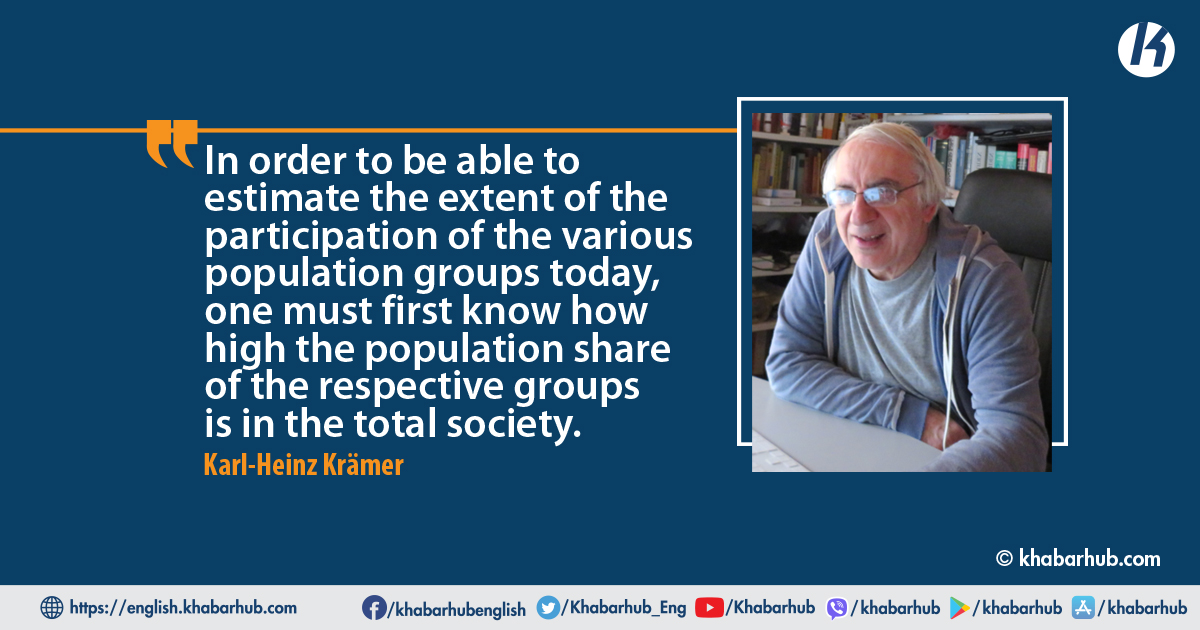Since 1990, the Nepali state has committed itself in its constitutions to multiethnicity, multilingualism and religious diversity in its society. This reality was reaffirmed in the current constitution of 2015.
At the same time, another commitment was added, namely that of ending the existing unequal participation of diverse social groups in the state. In 2006, during Jana Andolan II, this had been one of the most urgent concerns of the people and had subsequently been declared a priority goal by all political parties.
Yet this concern was not entirely new in 2006. It had been raised by members of disadvantaged groups as early as 1990, but had not really been heard.
The Nepal Janajati Mahasangh, now Nepal Adivasi Janajati Mahasangh, the alliance of representative organisations of ethnic groups, was still in its infancy at the beginning of the 1990s. Similar representations of the interests of the Madheshi and Dalits were more or less nowhere in sight.
Historical manipulations of the census
In order to be able to estimate the extent of the participation of the various population groups today, one must first know how high the population share of the respective groups is in the total society.
It gives people a very individual personal position in the multi-ethnic, multi-lingual and multi-religious state of Nepal. Beyond that, however, it also has very special political and administrative significance. Let’s just take the right to vote, which in the proportional system refers to the very figures published in the census for percentage allocation.
Until now, a look at the published data of the census, which has been published more or less regularly every ten years since 1911, has provided information on this.
For a long time, the last well-founded census with detailed data on ethnic groups/castes, languages and religions had been the 1961 census, which was compiled immediately after Mahendra’s royal coup in 1960 and was still largely free of the manipulations of the panchayat system.
The party-less royal panchayat system focused on faking a cultural unitary state in the decades that followed. The impact of this policy can be seen in the published data of the 1971 and 1981 censuses.
The number of ethnic groups listed constantly decreased, as did the number of mother tongues and their speakers. At the same time, the pretended number of practising Hindus rose to almost 90 per cent.
The evidence for the obviously fake data was provided by the censuses after the democratisation of 1990, according to which the proportion of Hindus fell to around 80 per cent (2001).
The proportion of native Nepali speakers fell from 58.4 per cent (1981) to 44.6 per cent (2011). While 44 mother tongues were counted in 1952/3, their number dropped to 17 (1971). In the 2011 census, 123 mother tongues were then listed by name. All this was to be seen as a positive development with regard to the appropriate inclusion of all social groups.
Shortcomings of the 2021 Census
And now the census of 2021, whose data was published barely one and a half years after it was collected. However, if you look for the latest data on the aforementioned social and cultural areas, you will be surprised to find that there are absolutely no figures.
This did not even happen under the royal panchayat system, although this system actually aimed at avoiding such data.
At best, a justification is provided by point 13.5 of the introductory notes of the new census, which states: “People’s aspirations and expectations have been elevated by the new Constitution. Issues of identities and capturing government’s attention are high.
As a result, some interest groups tried to manipulate the respondents’ independent answers and dictated the enumerators to write a particular response.
But this was independently verified and a press note was released from the CBS no fying all the concerned parties for possible legal action if they did not seize campaigning with prejudice.
Moreover, a number of interest groups especially related to caste/ethnicity, religion and language have shown serious concern on census results and presented their specific demands which need to be dealt with higher government or political level.”
This explanation is very significant in many respects. First of all, the very special importance of identity is emphasised. This can only be emphatically confirmed.
But it is also important to recognise changes in the field of inclusion. This is also and especially important for classifying possible positive changes with regard to traditionally excluded population groups.
It gives people a very individual personal position in the multi-ethnic, multi-lingual and multi-religious state of Nepal. Beyond that, however, it also has very special political and administrative significance. Let’s just take the right to vote, which in the proportional system refers to the very figures published in the census for percentage allocation.
The figures must also be made public in order to comply with the inclusion regulations in the political and administrative sphere.
Then the above quote goes on to say that some vested interests have tried to manipulate the data collection in this regard.
Nepal’s constitution guarantees the fundamental right to information. If the CBS makes such allegations in such an important document as the census report, then these vested interests must be named and legal action must be taken immediately.
While the CBS speaks of having threatened such legal action, it remains unclear whether it has been initiated.
In this context, there is talk of “concerned parties”. Does this refer to political parties or to “groups” in general? The next sentence talks about “interest groups related to caste/ethnicity, religion and language”, which obviously had concerns about such social data. Who are these groups and what are the reasons for their concerns?
The bottom line is that, while passage 13.5 of the introductory remarks to the census explains problems encountered during the survey, it does not explain why, for the first time, the census does not include any data on ethnicity, languages and religions. In view of the special political, electoral and administrative significance of such data, the Census loses quite considerably in value, however good and informative the data now published may be.
Here, the public interest of the population and the state is clearly to be valued higher than possible reservations of certain groups or individuals.
The question remains: Are there specific reasons why the social data were swept under the table? Possibly, they could prove the failure of the previous inclusion policy and, on the other hand, give impetus to demands of the excluded groups to remedy deficiencies.
So to return to the initial question: What has been achieved so far of the inclusion promised by all political parties in 2006?
For this, the public would not only have to be provided with new basic social data on ethnicity, languages and religions, but the respective proportion would also have to be shown for all possible areas of public life. It would be one of the most important tasks of the census in general to provide such data.
In order to recognise that male Khas Arya, especially Bahun, hold many times the posts and functions in the state system that are appropriate to them on the basis of their population share, new census data is not necessarily needed.
But it is also important to recognise changes in the field of inclusion. This is also and especially important for classifying possible positive changes with regard to traditionally excluded population groups.
So the vague hope remains that the missing data will still be supplied. There is no indication of this. Such data should actually be taken into account and integrated in the tables already published. But this is hardly likely to happen.
Only then would it be possible to see whether the various social groups in the areas covered by the census are affected or involved differently.
The question remains: Are there specific reasons why the social data were swept under the table? Possibly, they could prove the failure of the previous inclusion policy and, on the other hand, give impetus to demands of the excluded groups to remedy deficiencies.
(The views expressed in this article are those of the author’s and do not necessarily reflect the official policy or position of Khabarhub)








Comment